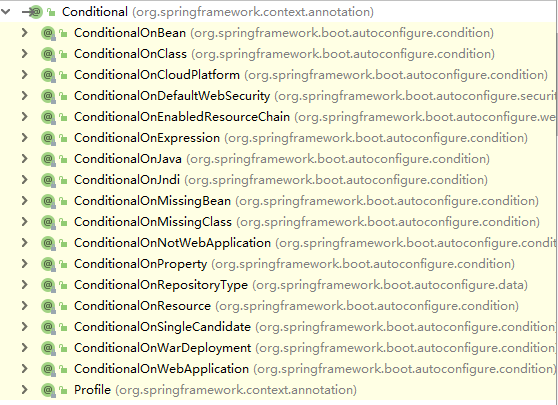介绍一些常用注解。
springBoot因为很少用到xml来配置bean文件,所以大部分都是用注解来创建和管理相关bean。
@Component、 @Service、 @Repository 和 @Controller这几个注解效果都是差不多的,都是可以用来创建bean实例的。只是规定使用的方法不同而已。
1. @Component
自动被component扫描
2. @Controller
用于web层
3. @Service
用于service层
4. @Repository
用于数据存储层
5. @Bean
bean注解用于告诉方法,产生一个Bean对象,然后交由Spring容器管理。 多用于@Configuration注解修饰的配置类中使用。
6. @Configuration
告诉SpringBoot修饰的类是一个配置类。@Bean修饰的animal即bean名称。
public class Animal {
private String name;
public Animal() {
}
public Animal(String name) {
this.name = name;
}
public String getName() {
return name;
}
public void setName(String name) {
this.name = name;
}
}配置类:
@Configuration
public class MyConfig {
@Bean
public Animal animal(){
return new Animal("cat");
}
}启动:
@SpringBootApplication
public class MainApplication {
public static void main(String[] args) {
ConfigurableApplicationContext context = SpringApplication.run(MainApplication.class, args);
Animal animal1 = context.getBean(Animal.class);
System.out.println(animal1.getName());
Animal animal2 = (Animal) context.getBean("animal");
System.out.println(animal2.getName());
System.out.println(animal1 == animal2);
}
}输出:
cat
cat
true@Bean和@Configuration配合使用,@Bean修饰的animal方法,将Animal也添加到spring的管理中。重复调用getBean(),获得的也都是同一个对象。
7. @Import
可以手动导入组件。默认调用无参构造器创建类。
@Import(Animal.class)
@Configuration
public class MyConfig {
}8. @Conditional
条件装配。可以根据各种情况来装配组件。

例如 ConditionalOnBean ,就是在bean存在的情况下再来装配所修饰的组件。
我建了一个和Animal类似的类,Plant。
@ConditionalOnBean:
@Configuration
public class MyConfig {
@Bean
public Plant plant() {
return new Plant("flower");
}
@Bean
@ConditionalOnBean(Plant.class)
public Animal animal() {
return new Animal("cat");
}
}@SpringBootApplication
public class MainApplication {
public static void main(String[] args) {
ConfigurableApplicationContext context = SpringApplication.run(MainApplication.class, args);
Animal animal = context.getBean(Animal.class);
System.out.println(animal.getName());
}
}输出:
cat如果把这plant注册的代码删掉,在获取Animal的时候则会报bean不存在的错
org.springframework.beans.factory.NoSuchBeanDefinitionException: No qualifying bean of type 'com.yt.myboot.entity.Animal' available9. @ImportResource
导入xml配置,相当于利用以前的xml来导入bean组件。
@Configuration
@ImportResource("classpath:xxx.xml")
public class MyConfig {
}10. @ConfigurationProperties
将properties配置的内容绑定到javaBean的属性中。
首先,我们先将之前写的@Configuration中自动注册Animal的方法去掉。
然后,给Animal类再添加一个属性age。在使用ConfigurationProperties之前要保证对象是spring容器中的组件,所以要加一个@Component注解。prefix是Properties配置文件中的前缀。
@Component
@ConfigurationProperties(prefix = "animal")
public class Animal {
private String name;
private Integer age;
public Animal() {
}
public Animal(String name) {
this.name = name;
}
public String getName() {
return name;
}
public void setName(String name) {
this.name = name;
}
public Integer getAge() {
return age;
}
public void setAge(Integer age) {
this.age = age;
}
}application.properties:
animal.name=cat
animal.age=3测试:
public static void main(String[] args) {
ConfigurableApplicationContext context = SpringApplication.run(MainApplication.class, args);
Animal animal = context.getBean(Animal.class);
System.out.println(animal.getName() + ":" + animal.getAge());
}输出:
cat:311. @EnableConfigurationProperties
启动配置注解。作用是使得用 @ConfigurationProperties 注解的类生效。
前面说过,使用@ConfigurationProperties注解,得要保证对象是spring容器中的组件,所以要加上@Component注解。
但是,如果不想要加@Component注解也可以,把@Component去掉,然后再配置类上加上@EnableConfigurationProperties,标明是哪一个类即可。
@ConfigurationProperties(prefix = "animal")
public class Animal {
......
}配置类:
@Configuration
@EnableConfigurationProperties(Animal.class)
public class MyConfig {
}输出一样是
cat:3